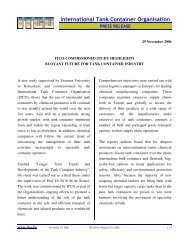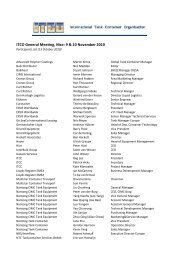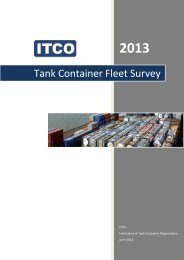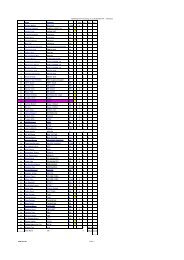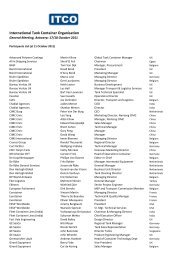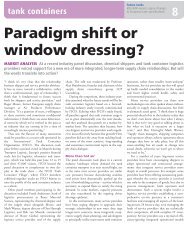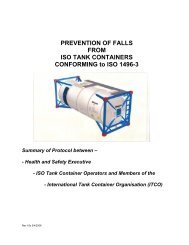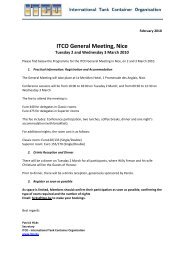Create successful ePaper yourself
Turn your PDF publications into a flip-book with our unique Google optimized e-Paper software.
ICHCA International <strong>Safe</strong>ty Panel Briefing Pamphlet No 30<br />
These instructions apply to liquid and solid substances <strong>of</strong> classes 3 to 9.<br />
Instruction<br />
Min test<br />
pressure (bar)<br />
Min shell<br />
thickness<br />
Pressure-relief<br />
provision<br />
Bottom opening<br />
provision<br />
T1 1.5 See 6.7.2.4.2 Normal See 6.7.2.6.2<br />
T2 1.5 See 6.7.2.4.2 Normal See 6.7.2.6.3<br />
T3 2.65 See 6.7.2.4.2 Normal See 6.7.2.6.2<br />
Table A5.1<br />
A5.1.3.6 When no Instruction appears in the Dangerous Goods List, transport <strong>of</strong><br />
the substance in portable tanks is not permitted unless a competent<br />
authority approval is granted.<br />
A5.1.3.7 Special Provisions are assigned to specific dangerous goods in column<br />
14 <strong>of</strong> the Dangerous Goods List in chapter 3.2. Each Special Provision is<br />
identified by an alpha-numeric designation (TP1 to TP91). Examples <strong>of</strong><br />
Special Provisions are shown in Table A5.2:<br />
TP7 Air shall be eliminated from the vapour space by nitrogen or<br />
other means<br />
TP13 Self-contained breathing apparatus shall be provided when<br />
this substance is transported<br />
TP20 This substance shall only be transported in insulated tanks<br />
under a nitrogen blanket<br />
Table A5.2<br />
A5.1.3.8 When a specific portable tank instruction is specified in the Dangerous<br />
Goods List, additional portable tanks which possess higher test<br />
pressures, greater shell thicknesses, more stringent bottom opening and<br />
pressure relief device arrangements may be used.<br />
A5.1.4 Dangerous goods are assigned UN numbers and proper shipping names<br />
according to their hazard classification and their composition. Dangerous<br />
goods commonly carried are listed in the Dangerous Goods List.<br />
A5.1.5 Where an article or substance is specifically listed by name (proper shipping<br />
name) this is the name that must be used for transportation documents.<br />
Example UN 1090 Acetone<br />
A5.1.6 UN numbers are also given for clearly defined groups <strong>of</strong> substances or<br />
articles.<br />
Example UN 1133 Adhesives<br />
A5.1.7 For dangerous goods not specifically listed by name “Not Otherwise<br />
Specified” (NOS) is used to cover a group <strong>of</strong> substances or articles.<br />
A5.1.8 Specific NOS entries covering a group <strong>of</strong> substances or articles <strong>of</strong> a<br />
particular chemical or technical nature<br />
Example UN 1477 Nitrates, Inorganic, NOS<br />
Page 64 ©ICHCA International Limited



